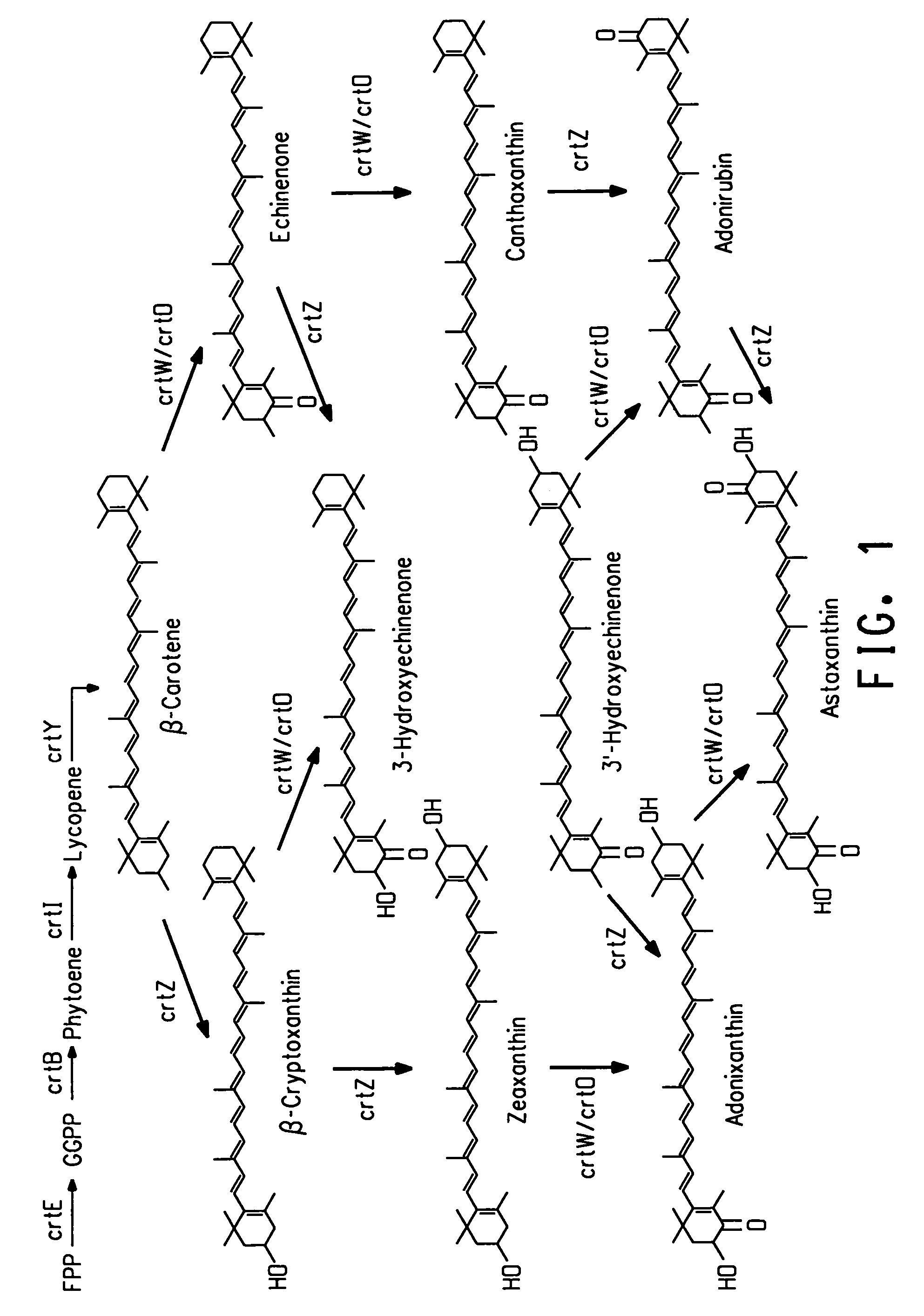Bacterial hemoglobin genes and their use to increase carotenoid production
a technology of bacterial hemoglobin and gene expression, applied in the field of microorganisms and molecular biology, can solve the problems of increasing dissolved oxygen mechanistically, adversely affecting the conversion of -carotene to canthaxanthin and/or astaxanthin, and various intermediates in the pathway, etc., and achieve the effect of increasing the growth rate of the transformed host cell
- Summary
- Abstract
- Description
- Claims
- Application Information
AI Technical Summary
Benefits of technology
Problems solved by technology
Method used
Image
Examples
example 1
Isolation of Methylomonas sp. 16a
[0242]The original environmental sample containing the isolate was obtained from pond sediment. The pond sediment was inoculated directly into defined medium with ammonium as the nitrogen source under 25% methane in air. Methane was the sole source of carbon and energy. Growth was followed until the optical density at 660 nm was stable, whereupon the culture was transferred to fresh medium such that a 1:100 dilution was achieved. After 3 successive transfers with methane as the sole carbon and energy source, the culture was plated onto BTZ-3 agar with ammonium as nitrogen source and incubated under 25% methane in air. Many methanotrophic bacterial species were isolated in this manner. However, Methylomonas sp. 16a was selected as the organism to study due to its rapid growth of colonies, large colony size, ability to grow on minimal media, and pink pigmentation indicative of an active biosynthetic pathway for carotenoids. Methylomonas sp. 16a has bee...
example 2
Genomic Sequencing of Methylomonas sp. 16a
[0243]Genomic DNA was isolated from Methylomonas sp. 16a according to standard protocols. Genomic DNA and library construction were prepared according to published protocols (Fraser et al., Science, 270 (5235):397–403 (1995)). A cell pellet was resuspended in a solution containing 100 mM Na-EDTA pH 8.0, 10 mM Tris-HCl pH 8.0, 400 mM NaCl, and 50 mM MgCl2.
[0244]Genomic DNA preparation After resuspension, the cells were gently lysed in 10% SDS (sodium dodecyl sulfate), and incubated for 30 min at 55° C. After incubation at room temperature, proteinase K was added to 100 μg / mL and incubated at 37° C. until the suspension was clear. DNA was extracted twice with Tris-equilibrated phenol and twice with chloroform. DNA was precipitated in 70% ethanol and resuspended in a solution containing 10 mM Tris-HCl and 1 mM Na-EDTA (TE), pH 7.5. The DNA solution was treated with a mix of RNAases, then extracted twice with Tris-equilibrated phenol and twice w...
example 3
Identification of Bacterial Hemoglobin Genes from Methylomonas
[0247]All sequences from Example 2 were identified by conducting BLAST (Basic Local Alignment Search Tool; Altschul, S. F., et al., J. Mol. Biol., 215:403–410 (1993)) searches for similarity to sequences contained in the BLAST “nr” database (comprising all non-redundant GenBank® CDS translations, sequences derived from the 3-dimensional structure Brookhaven Protein Data Bank, the SWISS-PROT protein sequence database, EMBL, and DDBJ databases). The sequences were analyzed for similarity to all publicly available DNA sequences contained in the “nr” database using the BLASTN algorithm provided by the National Center for Biotechnology Information (NCBI). The DNA sequences were translated in all reading frames and compared for similarity to all publicly available protein sequences contained in the “nr” database using the BLASTX algorithm (Gish, W., and States, D. J., Nature Genetics, 3:266–272 (1993)) provided by the NCBI. Al...
PUM
| Property | Measurement | Unit |
|---|---|---|
| temperature | aaaaa | aaaaa |
| temperature | aaaaa | aaaaa |
| temperature | aaaaa | aaaaa |
Abstract
Description
Claims
Application Information
 Login to View More
Login to View More - R&D
- Intellectual Property
- Life Sciences
- Materials
- Tech Scout
- Unparalleled Data Quality
- Higher Quality Content
- 60% Fewer Hallucinations
Browse by: Latest US Patents, China's latest patents, Technical Efficacy Thesaurus, Application Domain, Technology Topic, Popular Technical Reports.
© 2025 PatSnap. All rights reserved.Legal|Privacy policy|Modern Slavery Act Transparency Statement|Sitemap|About US| Contact US: help@patsnap.com



